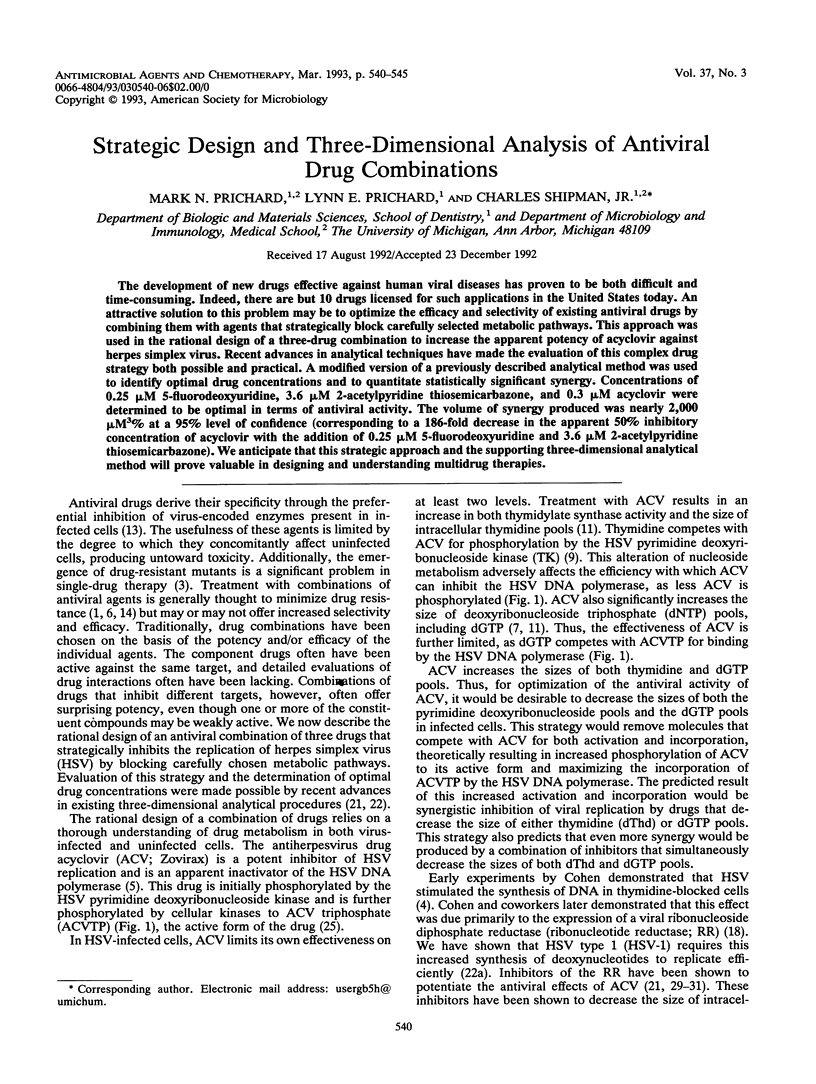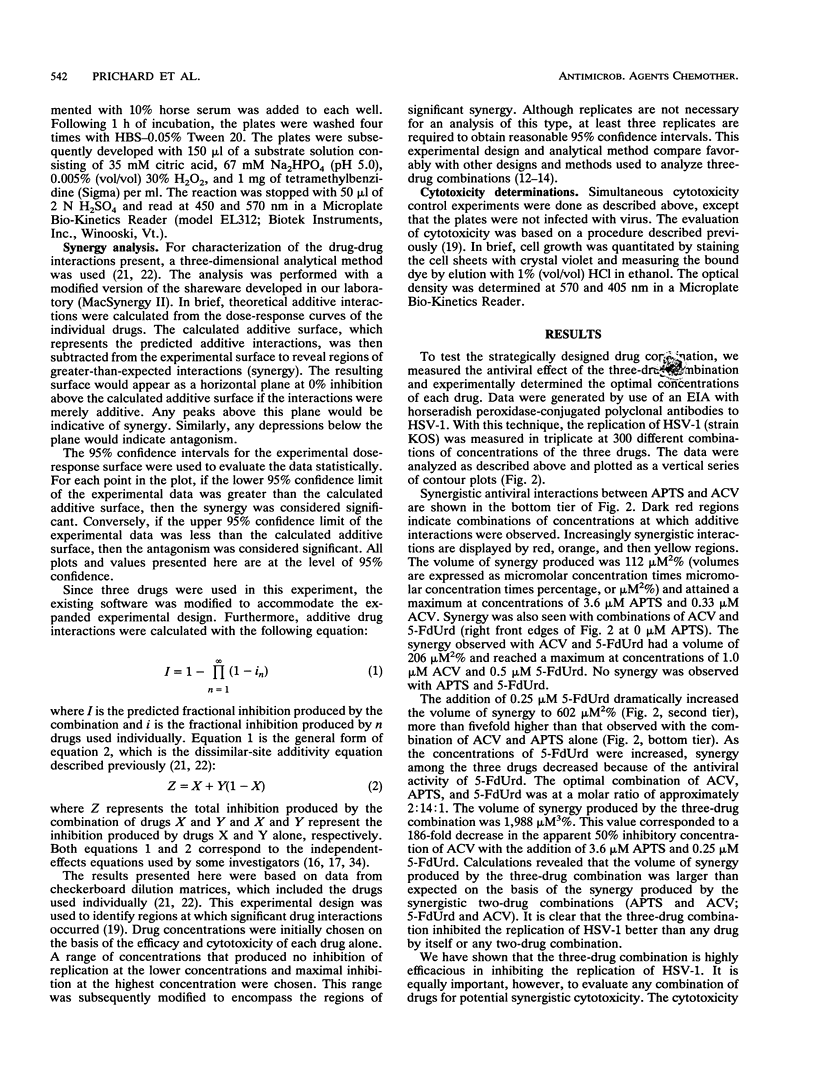Abstract
The development of new drugs effective against human viral diseases has proven to be both difficult and time-consuming. Indeed, there are but 10 drugs licensed for such applications in the United States today. An attractive solution to this problem may be to optimize the efficacy and selectivity of existing antiviral drugs by combining them with agents that strategically block carefully selected metabolic pathways. This approach was used in the rational design of a three-drug combination to increase the apparent potency of acyclovir against herpes simplex virus. Recent advances in analytical techniques have made the evaluation of this complex drug strategy both possible and practical. A modified version of a previously described analytical method was used to identify optimal drug concentrations and to quantitate statistically significant synergy. Concentrations of 0.25 microM 5-fluorodeoxyuridine, 3.6 microM 2-acetylpyridine thiosemicarbazone, and 0.3 microM acyclovir were determined to be optimal in terms of antiviral activity. The volume of synergy produced was nearly 2,000 microM3% at a 95% level of confidence (corresponding to a 186-fold decrease in the apparent 50% inhibitory concentration of acyclovir with the addition of 0.25 microM 5-fluorodeoxyuridine and 3.6 microM 2-acetylpyridine thiosemicarbazone). We anticipate that this strategic approach and the supporting three-dimensional analytical method will prove valuable in designing and understanding multidrug therapies.
Full text
PDF





Images in this article
Selected References
These references are in PubMed. This may not be the complete list of references from this article.
- Ban J., Weber G. Synergistic action of tiazofurin and difluorodeoxycytidine on differentiation and cytotoxicity. Biochem Biophys Res Commun. 1992 Apr 30;184(2):551–559. doi: 10.1016/0006-291x(92)90625-u. [DOI] [PubMed] [Google Scholar]
- Bianchi V., Pontis E., Reichard P. Changes of deoxyribonucleoside triphosphate pools induced by hydroxyurea and their relation to DNA synthesis. J Biol Chem. 1986 Dec 5;261(34):16037–16042. [PubMed] [Google Scholar]
- Coen D. M. The implications of resistance to antiviral agents for herpesvirus drug targets and drug therapy. Antiviral Res. 1991 May;15(4):287–300. doi: 10.1016/0166-3542(91)90010-o. [DOI] [PubMed] [Google Scholar]
- Cohen G. H. Ribonucleotide reductase activity of synchronized KB cells infected with herpes simplex virus. J Virol. 1972 Mar;9(3):408–418. doi: 10.1128/jvi.9.3.408-418.1972. [DOI] [PMC free article] [PubMed] [Google Scholar]
- Freestone D. S. The need for new antiviral agents. Antiviral Res. 1985 Dec;5(6):307–324. doi: 10.1016/0166-3542(85)90001-4. [DOI] [PMC free article] [PubMed] [Google Scholar]
- Furman P. A., Lambe C. U., Nelson D. J. Effect of acyclovir on the deoxyribonucleoside triphosphate pool levels in Vero cells infected with herpes simplex virus type 1. Am J Med. 1982 Jul 20;73(1A):14–17. doi: 10.1016/0002-9343(82)90056-0. [DOI] [PubMed] [Google Scholar]
- Garrett C., Santi D. V. A rapid and sensitive high pressure liquid chromatography assay for deoxyribonucleoside triphosphates in cell extracts. Anal Biochem. 1979 Nov 1;99(2):268–273. doi: 10.1016/s0003-2697(79)80005-6. [DOI] [PubMed] [Google Scholar]
- Harmenberg J. Intracellular pools of thymidine reduce the antiviral action of acyclovir. Intervirology. 1983;20(1):48–51. doi: 10.1159/000149373. [DOI] [PubMed] [Google Scholar]
- Karlsson A. H., Harmenberg J. G., Wahren B. E. Influence of acyclovir and bucyclovir on nucleotide pools in cells infected with herpes simplex virus type 1. Antimicrob Agents Chemother. 1986 May;29(5):821–824. doi: 10.1128/aac.29.5.821. [DOI] [PMC free article] [PubMed] [Google Scholar]
- Kong X. B., Zhu Q. Y., Ruprecht R. M., Watanabe K. A., Zeidler J. M., Gold J. W., Polsky B., Armstrong D., Chou T. C. Synergistic inhibition of human immunodeficiency virus type 1 replication in vitro by two-drug and three-drug combinations of 3'-azido-3'-deoxythymidine, phosphonoformate, and 2',3'-dideoxythymidine. Antimicrob Agents Chemother. 1991 Oct;35(10):2003–2011. doi: 10.1128/aac.35.10.2003. [DOI] [PMC free article] [PubMed] [Google Scholar]
- McKinlay M. A., Rossmann M. G. Rational design of antiviral agents. Annu Rev Pharmacol Toxicol. 1989;29:111–122. doi: 10.1146/annurev.pa.29.040189.000551. [DOI] [PubMed] [Google Scholar]
- Meng T. C., Fischl M. A., Boota A. M., Spector S. A., Bennett D., Bassiakos Y., Lai S. H., Wright B., Richman D. D. Combination therapy with zidovudine and dideoxycytidine in patients with advanced human immunodeficiency virus infection. A phase I/II study. Ann Intern Med. 1992 Jan 1;116(1):13–20. doi: 10.7326/0003-4819-116-1-13. [DOI] [PubMed] [Google Scholar]
- Nutter L. M., Grill S. P., Cheng Y. C. The sources of thymidine nucleotides for virus DNA synthesis in herpes simplex virus type 2-infected cells. J Biol Chem. 1985 Oct 25;260(24):13272–13275. [PubMed] [Google Scholar]
- Ponce de Leon M., Eisenberg R. J., Cohen G. H. Ribonucleotide reductase from herpes simplex virus (types 1 and 2) infected and uninfected KB cells: properties of the partially purified enzymes. J Gen Virol. 1977 Jul;36(1):163–173. doi: 10.1099/0022-1317-36-1-163. [DOI] [PubMed] [Google Scholar]
- Prichard M. N., Prichard L. E., Baguley W. A., Nassiri M. R., Shipman C., Jr Three-dimensional analysis of the synergistic cytotoxicity of ganciclovir and zidovudine. Antimicrob Agents Chemother. 1991 Jun;35(6):1060–1065. doi: 10.1128/aac.35.6.1060. [DOI] [PMC free article] [PubMed] [Google Scholar]
- Prichard M. N., Shipman C., Jr A three-dimensional model to analyze drug-drug interactions. Antiviral Res. 1990 Oct-Nov;14(4-5):181–205. doi: 10.1016/0166-3542(90)90001-n. [DOI] [PubMed] [Google Scholar]
- Prichard M. N., Turk S. R., Coleman L. A., Engelhardt S. L., Shipman C., Jr, Drach J. C. A microtiter virus yield reduction assay for the evaluation of antiviral compounds against human cytomegalovirus and herpes simplex virus. J Virol Methods. 1990 Apr;28(1):101–106. doi: 10.1016/0166-0934(90)90091-s. [DOI] [PubMed] [Google Scholar]
- Pöch G., Reiffenstein R. J., Unkelbach H. D. Application of the isobologram technique for the analysis of combined effects with respect to additivity as well as independence. Can J Physiol Pharmacol. 1990 Jun;68(6):682–688. doi: 10.1139/y90-103. [DOI] [PubMed] [Google Scholar]
- Rammler D. H. Periodate oxidations of enamines. I. Oxidation of adenosine 5'-monophosphate in the presence of methylamine. Biochemistry. 1971 Dec 7;10(25):4699–4705. doi: 10.1021/bi00801a016. [DOI] [PubMed] [Google Scholar]
- Reardon J. E., Spector T. Acyclovir: mechanism of antiviral action and potentiation by ribonucleotide reductase inhibitors. Adv Pharmacol. 1991;22:1–27. doi: 10.1016/s1054-3589(08)60031-9. [DOI] [PubMed] [Google Scholar]
- Shipman C., Jr Evaluation of 4-(2-hydroxyethyl)-1-piperazineëthanesulfonic acid (HEPES) as a tissue culture buffer. Proc Soc Exp Biol Med. 1969 Jan;130(1):305–310. doi: 10.3181/00379727-130-33543. [DOI] [PubMed] [Google Scholar]
- Shipman C., Jr, Smith S. H., Drach J. C., Klayman D. L. Antiviral activity of 2-acetylpyridine thiosemicarbazones against herpes simplex virus. Antimicrob Agents Chemother. 1981 Apr;19(4):682–685. doi: 10.1128/aac.19.4.682. [DOI] [PMC free article] [PubMed] [Google Scholar]
- Shipman C., Jr, Smith S. H., Drach J. C., Klayman D. L. Thiosemicarbazones of 2-acetylpyridine, 2-acetylquinoline, 1-acetylisoquinoline, and related compounds as inhibitors of herpes simplex virus in vitro and in a cutaneous herpes guinea pig model. Antiviral Res. 1986 Jul;6(4):197–222. doi: 10.1016/0166-3542(86)90002-1. [DOI] [PubMed] [Google Scholar]
- Spector T., Averett D. R., Nelson D. J., Lambe C. U., Morrison R. W., Jr, St Clair M. H., Furman P. A. Potentiation of antiherpetic activity of acyclovir by ribonucleotide reductase inhibition. Proc Natl Acad Sci U S A. 1985 Jun;82(12):4254–4257. doi: 10.1073/pnas.82.12.4254. [DOI] [PMC free article] [PubMed] [Google Scholar]
- Spector T., Harrington J. A., Morrison R. W., Jr, Lambe C. U., Nelson D. J., Averett D. R., Biron K., Furman P. A. 2-Acetylpyridine 5-[(dimethylamino)thiocarbonyl]-thiocarbonohydrazone (A1110U), a potent inactivator of ribonucleotide reductases of herpes simplex and varicella-zoster viruses and a potentiator of acyclovir. Proc Natl Acad Sci U S A. 1989 Feb;86(3):1051–1055. doi: 10.1073/pnas.86.3.1051. [DOI] [PMC free article] [PubMed] [Google Scholar]
- Spector T., Harrington J. A., Porter D. J. Herpes and human ribonucleotide reductases. Inhibition by 2-acetylpyridine 5-[(2-chloroanilino)-thiocarbonyl]-thiocarbonohydrazone (348U87). Biochem Pharmacol. 1991 Jun 21;42(1):91–96. doi: 10.1016/0006-2952(91)90685-x. [DOI] [PubMed] [Google Scholar]
- Turk S. R., Shipman C., Jr, Drach J. C. Selective inhibition of herpes simplex virus ribonucleoside diphosphate reductase by derivatives of 2-acetylpyridine thiosemicarbazone. Biochem Pharmacol. 1986 May 1;35(9):1539–1545. doi: 10.1016/0006-2952(86)90122-x. [DOI] [PubMed] [Google Scholar]
- Turk S. R., Shipman C., Jr, Drach J. C. Structure-activity relationships among alpha-(N)-heterocyclic acyl thiosemicarbazones and related compounds as inhibitors of herpes simplex virus type 1-specified ribonucleoside diphosphate reductase. J Gen Virol. 1986 Aug;67(Pt 8):1625–1632. doi: 10.1099/0022-1317-67-8-1625. [DOI] [PubMed] [Google Scholar]



